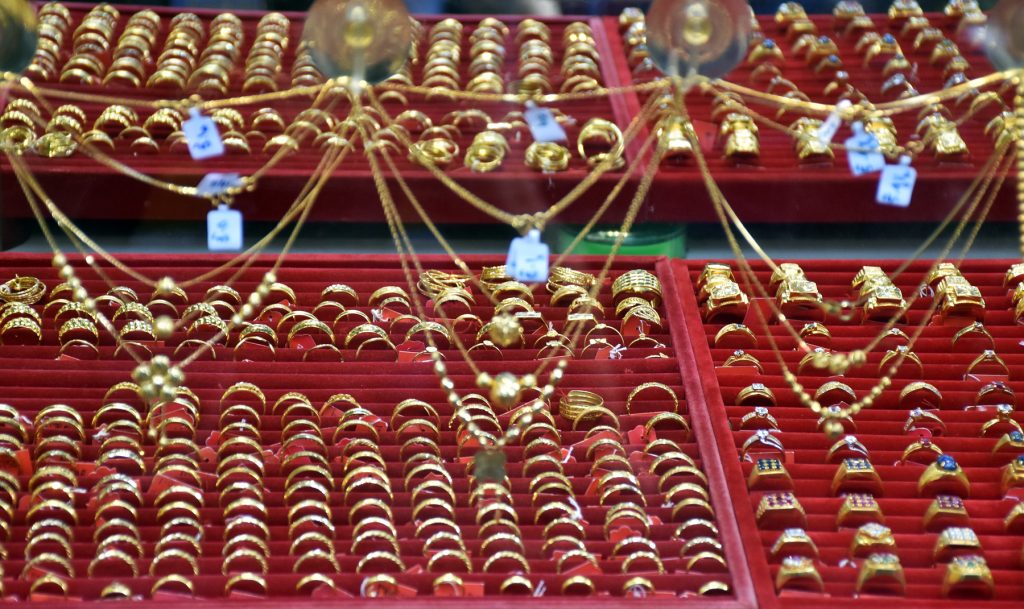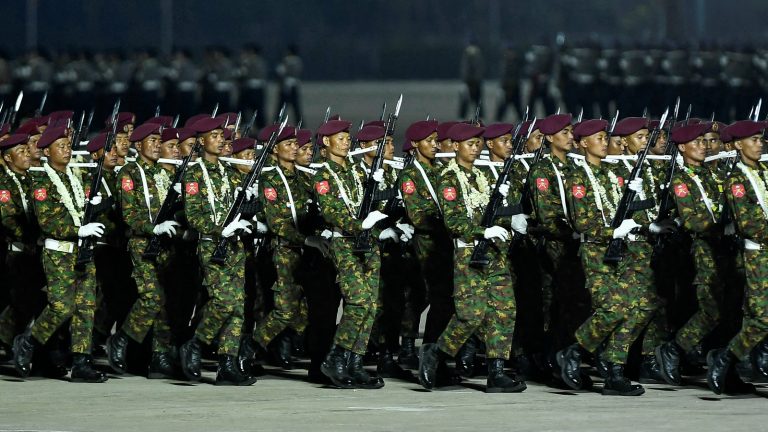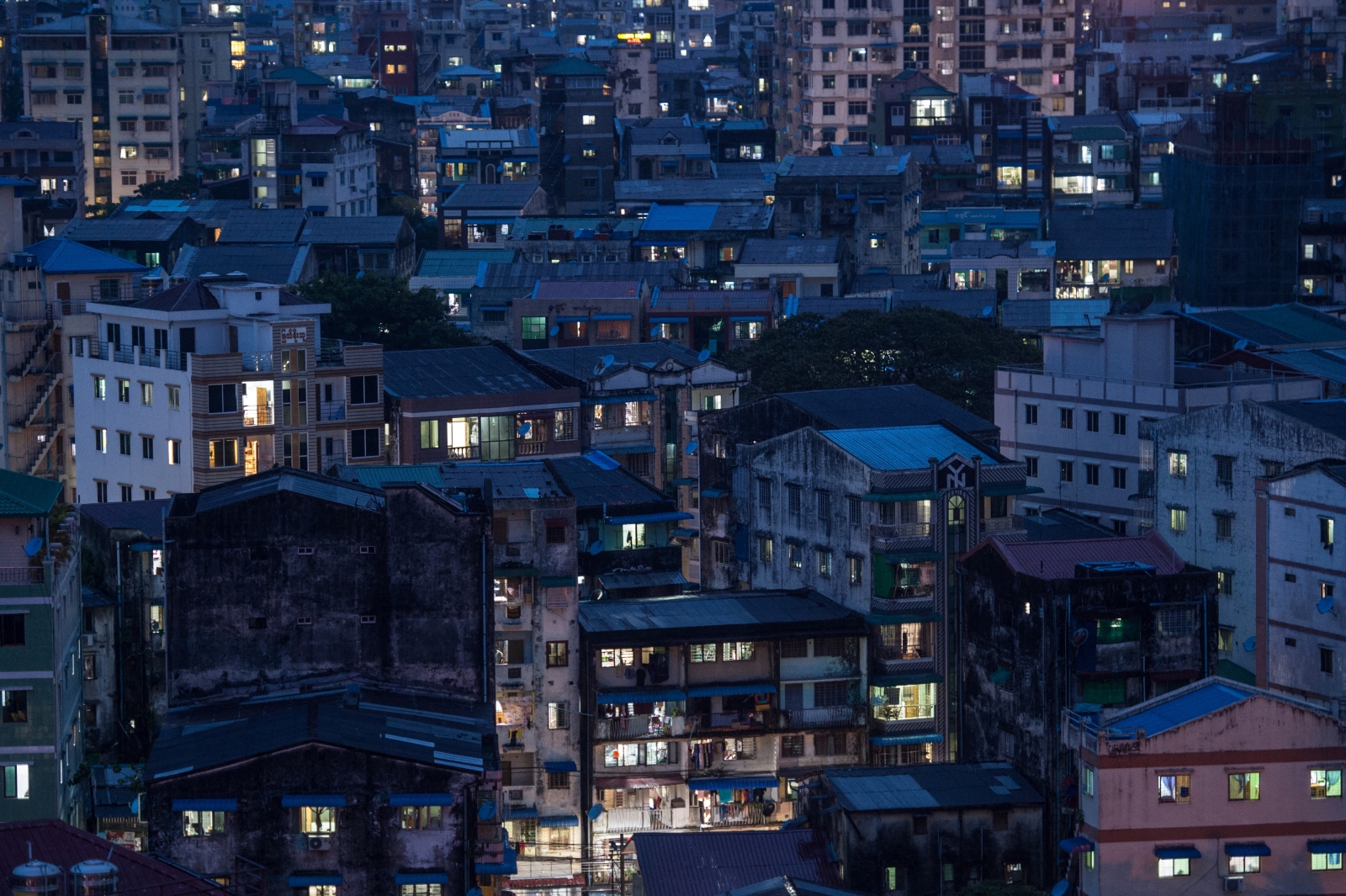The regime’s foreign exchange controls sparked a frenzy in gold smuggling to India, but since mid-May it has turned to familiar tactics – intimidation and onerous red tape – to control the trade.
By FRONTIER
Shwe Bon Thar Street in downtown Yangon has been the bustling hub of Myanmar’s gold trade since the colonial period, when it was known as Mogul Street. In recent months, however, its gold shops have gone unusually quiet.
Traders have deserted the market since mid-May due to a series of arrests and other interventions by the military regime aimed at controlling the trade and fighting rampant smuggling, speculation and hoarding.
In Myanmar, gold is a popular hedge against economic downturns. Sales have spiked since the February 2021 coup d’état, which sparked widespread resistance and crushed confidence in the economy. Banks have been forced to limit withdrawals, GDP has shrunk by close to 20 percent and the embattled regime has rolled back some of the key economic reforms of the last decade. Many consumers who rushed to withdraw savings from banks or had spare cash in hand were therefore keen to invest in ever-valuable gold.
Another popular hedge is US dollars but on April 3, the junta-controlled Central Bank of Myanmar introduced a new policy effectively freezing most foreign currency held at domestic banks. The Central Bank also ordered the banks to convert those foreign currency holdings into kyat at the fixed rate of K1,850 to the US dollar – below the then-market rate of about K2,000. These dollar restrictions created havoc for importers of fuel and edible oil and left those markets in chaos.
The Central Bank’s surprise moves also sent shockwaves through the business community more generally and further undermined confidence in the kyat. With dollars suddenly harder to come by, spooked investors turned to the gold market instead. “People were in shock after the announcement and the amount of gold being traded doubled overnight,” U Aung Ko*, a gold trader based on Shwe Bon Thar Street, told Frontier. “There were also speculators in the market, and both of these factors pushed prices up.”
U Myo Myint heads the Yangon Gold Entrepreneurs Association, a Shwe Bon Thar Street-based body that issues gold prices four times a day and runs the wholesale market. He confirmed to Frontier that the Central Bank announcement sparked a surge in gold sales. “People were withdrawing cash from the bank and queueing up to buy gold,” he said.
Although Myo Myint refused to give the overall volume of trade, he said bullion sales had doubled in the wake of the foreign currency controls. In normal times bullion typically accounts for at least 80pc of gold sales, Myo Myint said, with the rest being for jewellery and industrial use.
Many buyers appear to have been turning to gold to protect against kyat depreciation, or to speculate on future price movements. But the fixing of an artificially high official exchange rate for the kyat also led to gold being undervalued, and prompted what industry sources described as a massive surge in smuggling to the Indian border.
The gold-buying frenzy came to a screeching halt on May 16, when the authorities arrested nine gold traders. They have not publicly announced the arrests, let alone the specific charges, but Myo Myint said the YGEA was told that the traders were detained for allegedly manipulating the gold price and smuggling gold from Myanmar to India.
Industry sources approached by Frontier refused to speak on the record out of fear of retribution. Frontier understands that Central Bank Deputy Governor Daw Than Than Swe has forbidden anyone except Myo Myint from talking to the media about the gold market, in order to “control misinformation”.
The arrests, along with the introduction of a new licence for bullion trading, seem intended to take the sparkle out of the gold market by instilling fear in traders. If the quiet shops on Shwe Bon Thar are any indication, the measures have done their job.
Aung Ko has little doubt about the regime’s ultimate intentions. “They want to control the entire gold market,” he said.
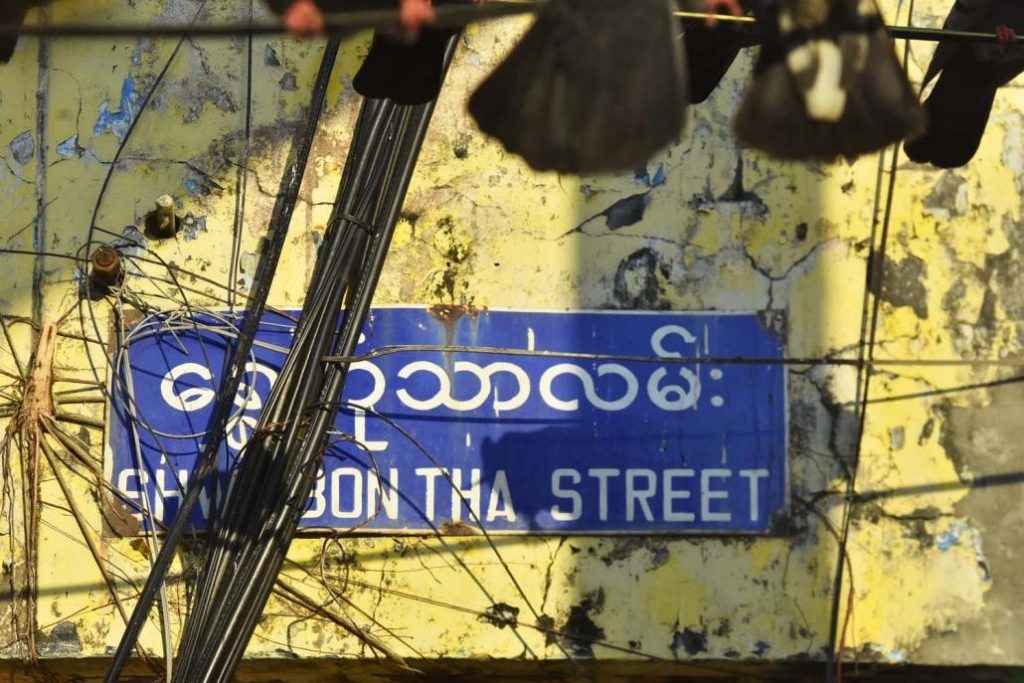
The ‘air’ market
A significant proportion of gold and jewellery sales have shifted online in recent years due to the COVID-19 pandemic. Shops and individual traders hold sales over Facebook Live, showing off their wares in an effort to drum up business. Famous entertainers are often paid to promote these sales, helping to create a thriving market.
Myo Myint, the YGEA chair, claimed online sales had been used to “manipulate” gold prices in recent months. He explained that some traders would search for gold buyers online who were willing to pay above the YGEA price, and after agreeing a price with a buyer they would then buy gold from the association and sell it on to them for a profit. He added that this practice was known as lay pat kar, or “verbal trading” (“lay” literally means air).
In this type of trading, gold (and money) actually changes hands. But traders told Frontier the Central Bank announcement also sparked an increase in another, more speculative type of lay pat kar, in which two parties agree to buy and sell gold at a particular price at a particular time and date. The traders are essentially making a bet on whether gold will rise or fall – known in finance as a “forward” contract – and usually no gold actually changes hands.
Traders said lay pat kar normally increases during times of volatility, adding that record-high global gold prices and the April 3 foreign exchange controls, along with Myanmar’s general economic instability, had created a perfect storm.
“All of these factors created a favourable environment for the lay pat kar market,” said Aung Ko, the gold trader. “It’s hard to say exactly how much this trading increased, but it was significant.”
Although lay pat kar is well-established in Myanmar – and extends to other commodities, from currencies to rice and even cars – authorities traditionally view it as a trigger for harmful currency instability and have periodically tried to crack down on it.
Traders who bet on movements in the gold price have been accused of manipulating it to their advantage by either buying or selling large amounts of gold, kyat or dollars. Gaming the market this way would be impossible in most countries, but Myanmar’s foreign exchange market is unusually thin, and one or two large transactions can move the kyat up or down. In late 2018, the authorities arrested gold and currency traders suspected of market manipulation after a sharp fall in the kyat, which they believed was being exacerbated by lay pat kar.
Some dispute that lay pat kar actually causes volatility, instead seeing it more as a symptom. The junta, however, seems convinced. In December last year, it formed a Monitoring and Steering Committee on Gold and Currency Market to “inspect and prosecute market manipulation, check if there is compliance with payment rules or not, and proceed against those unscrupulous traders”.
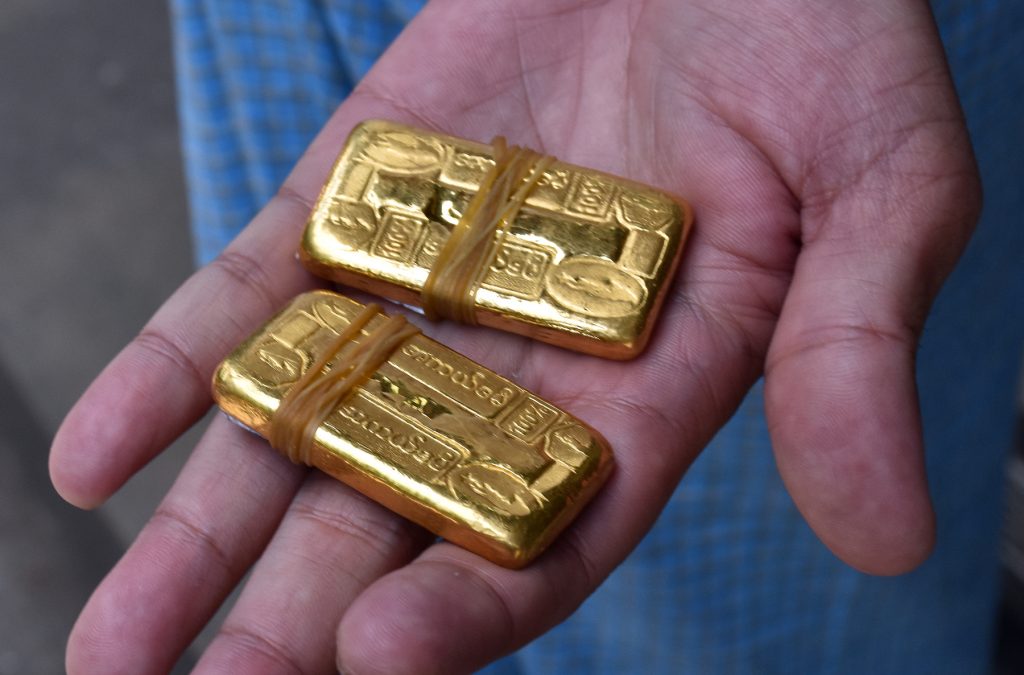
‘If you come, they’ll run away!’
Gold traders told Frontier that between April 3 and May 16, speculation was less of a problem than smuggling. And the rampant smuggling was a direct consequence of the regime’s foreign currency policy, particularly its attempt to peg the kyat at the artificially high rate of K1,850 to the US dollar, when it was trading on the black market for more than K2,000.
The gold and currency, particularly US dollar, markets are intrinsically linked. Typically, if the kyat rises or falls, the local gold price follows. If it doesn’t, then it can create arbitrage opportunities that encourage smuggling. But this phenomenon also normally self corrects; if the price is too low, increased demand for gold quickly pushes it back up.
After setting the currency peg, the Central Bank ordered the YGEA to base its gold price on the K1,850 exchange rate, and the association obliged. Myanmar gold usually trades at a premium to the global price, which is quoted in US dollars, but the official local price was suddenly on par with most of the world. This soon created parallel prices for gold: the official rate, and a higher market rate. At a May 4 meeting, the YGEA ordered retailers and traders to transact within K5,000 of the YGEA price per tical (a local measurement equivalent to 16.33 grams, 0.576 ounces and 0.525 troy ounces). This order, unsurprisingly, went unheeded.
Any visitor to the YGEA Facebook page would have quickly noticed the problem. Each day, the YGEA posts the daily gold price. Through April and the first half of May, these posts regularly featured comments either mocking the association or pointing out the disparity. On April 27, for example, one user wrote that while the association’s gold price was K2,044,000 per tical, gold shops were selling for K2,056,000, and they wanted to know which was correct. Another user simply commented, “Do you really need to ask?” On May 11, one user asked in apparent jest if they could come to the association’s office and buy at the day’s rate. One person replied, “If you come, they’ll run away!”
On Saturday May 14, the YGEA did not issue its daily price, suggesting something was happening behind the scenes. And when the market re-opened on May 16 – the day the traders were arrested – the local gold price was almost K90,000 higher, despite the global gold price having fallen. The YGEA had flipped to using the market rate.
Asked about the switch, Myo Myint confirmed that the Central Bank had initially told the association to base the gold price on the official exchange rate, but he said this had become impossible due to the large difference between the resulting local price and what gold was being bought for at the border. “So now we are calculating the index price on the actual market exchange rate,” he said.
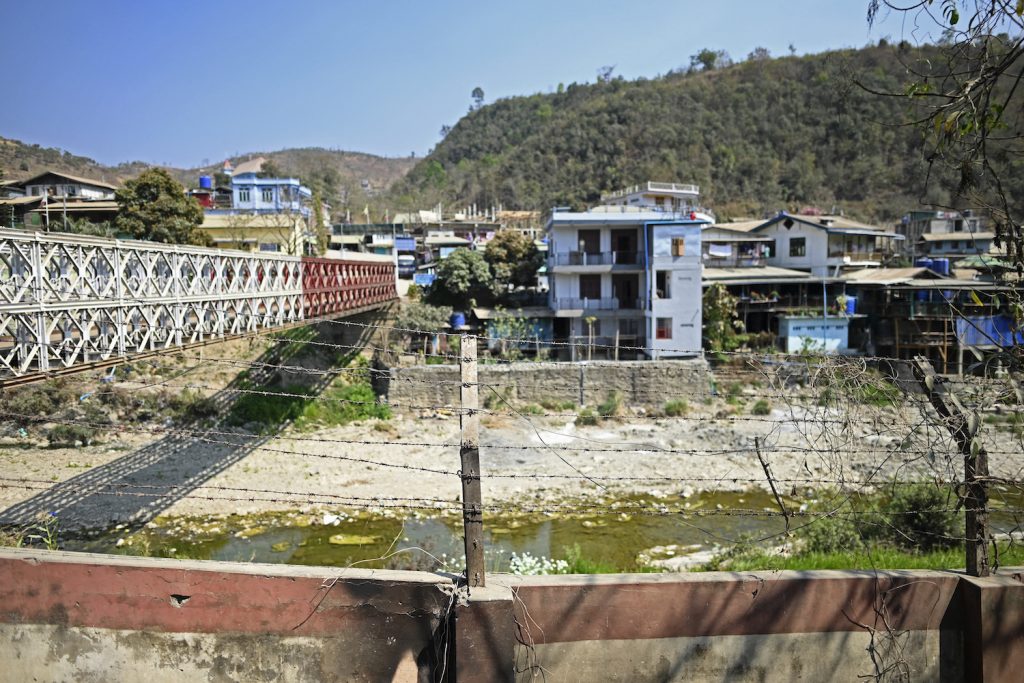
A smuggler’s paradise
Although Myanmar’s gold price tends to be slightly higher than the global rate, it’s nearly always lower than neighbouring India. One of the world’s largest gold markets, India levies a tax on imports that pushes up its gold price relative to many countries – and thus incentivises smuggling.
When the COVID-19 pandemic shut down air travel, Myanmar displaced the Middle East as India’s main source of smuggled gold, accounting for 69pc of all seizures in the 2020-21 financial year, according to the annual report of the country’s Directorate of Revenue Intelligence. Gold from Myanmar is usually smuggled from Chin State and Sagaing Region into India’s Mizoram and Manipur states, and from there distributed by road to major demand centres elsewhere in India.
While there had been some “spectacular” seizures in 2020-21, including one haul of almost 83 kilograms in December 2020, the DRI said a “huge quantity” of gold was being successfully smuggled in from Myanmar through these land routes.
Between April 3 and May 16 this year, when Myanmar’s gold price was artificially low, smugglers had more incentive than ever to send gold across the border to India. The Indian price was routinely 10-12pc higher, the equivalent of around US$200 an ounce.
Indian media reported a number of major seizures during this time, including 16 kilograms of gold from Myanmar concealed in three vehicles travelling together between Manipur and the neighbouring state of Assam.
Gold traders confirmed to Frontier that smuggling was rampant then and pointed the finger at those well-connected enough to access the official price through the YGEA. They said most of those who had been detained on May 16 were association members.
Myo Myint denied those responsible were members but acknowledged that the low price the YGEA set had led to a surge in smuggling. “Many were caught after buying at the YGEA and selling at the border. If you look at arrests in Tamu, you can see it is all ‘Academy’ branded gold – it is clearly from the YGEA,” he said, referring to one of the country’s major refiners. “Actually, everyone in the gold industry wants the local gold price to fall, and when it happens, they buy gold at the YGEA and smuggle it across the border.”
The scale of smuggling appears to have been so great that there were concerns of an impending gold shortage. A day before the Central Bank pegged the kyat at K1,850, state media had quoted Myo Myint as saying that gold sales were sluggish due to high prices. But barely a month later, the YGEA was forced to call an emergency meeting, at which it decided to import gold from abroad during the June-to-September rainy season, when domestic gold mining normally declines, in order to avoid a possible shortfall. Myo Myint was quoted at the time as saying that the association also wanted the Central Bank to sell gold on to the domestic market.
Myo Myint told Frontier that if the YGEA had continued to set the price based on the K1,850 exchange rate, Myanmar’s gold stocks would have disappeared. “We would have been left with nothing – it all would have gone across the border,” he said.
The YGEA chair declined to reveal exactly who was able to buy at the official price during this period, or even where the gold the YGEA was selling had come from. Although the YGEA maintained records of sales during this period, Myo Myint said it was not allowed to disclose them, even to its members.
Gold traders also refused to identify those involved, but said they were well known in the industry.
“Those arrested have been working in the business for a long time. They were working together with other people who weren’t arrested. No one is more guilty than anyone else; it’s just that some were unlucky enough to be arrested,” said U Aung Aung*, a major gold trader.
Aung Ko said that because YGEA had switched to calculating the local price based on the market rate, smuggling had declined. He suggested this had also contributed to the sudden drop in gold sales.
“You know how it works – if traders can’t make a profit, there’s not much incentive to trade,” he said.
But that’s not the only factor. At the same time as profits have gone down, the risk of trading gold has risen exponentially.

Resuming exports
A day after the May 16 arrests, the YGEA issued a seven-point notification. For the first time, it made mention of a licence to trade in bullion.
Previously, the only two licences linked to the gold business in Myanmar were for mining and running a gold shop. “Nobody has ever needed a licence to trade in pure gold bars before; they only needed a gold shop licence,” said Aung Ko.
The notification also said that transactions outside gold shops could only take place at the YGEA office, and payment should be made immediately. Border trade could only take place with the association’s permission, while shops and traders were now required to maintain inventories and record sales. It warned that action would be taken in response to any violations, including online sales without a licence.
The arrests and the new rules have devastated the market. Trade in bullion, as well as online trading and lay pat kar, have almost disappeared, three traders told Frontier.
“People who have accumulated pure gold bars can’t sell them because they don’t have a licence. As a result, the market is very quiet,” Aung Ko said.
Myo Myint said anyone wishing to sell bullion could get a letter of recommendation from the YGEA that they could use to support an application to the Yangon City Development Committee, the commercial capital’s municipal authority, for a gold bar trading licence. As of late June, the association had issued 70 letters.
“Those who apply for new licences also have to pay one year’s tax in advance. After that, YCDC will issue licences,” he said.
Initially, YCDC refused to accept applications for bullion licences on the grounds it was awaiting instructions from “the authorities”, an apparent reference to the junta, one gold trader told Frontier, asking not to be identified.
Another anonymous online gold trader said he was fearful of doing business because of concern about licences and the May arrests. “I was buying and reselling online gold jewellery that had been left at pawn shops, but now I’m too afraid,” he told Frontier in mid-June.
In late June, YCDC started processing applications. Aung Ko said a few had recently been issued, but sales were still slow, and most traders were waiting to see what would happen next.
Traders told Frontier that the regime seems intent on wresting control over the gold business, even at the cost of depressing the market. One theory is that it wants to be able to resume exports at a time of high global prices. This would enable the junta to earn foreign currency, which is apparently in short supply.
The National League for Democracy government started permitting gold exports in January 2018, and some sales to Japan and South Korea were reported. At the time, some in the industry believed exports could reach as much as 20 tonnes a year – the equivalent of around $1 billion at current prices. However, after the global Financial Action Task Force placed Myanmar on a watchlist in 2020, amid concerns about money-laundering by transnational drug traffickers and the weak regulation of Myanmar’s financial system, the NLD government banned exports again.
Late last year the junta green-lighted gold exports, subject to earnings being changed into kyat. Its Ministry of Commerce said on December 30 that gold up to a value of $50,000 could be exported with the use of telegraphic transfers, and exports exceeding $50,000 could be effected through letters of credit.
Myo Myint said the YGEA was in consultations with business owners on commencing exports, and that he expected official trade to resume early next year.
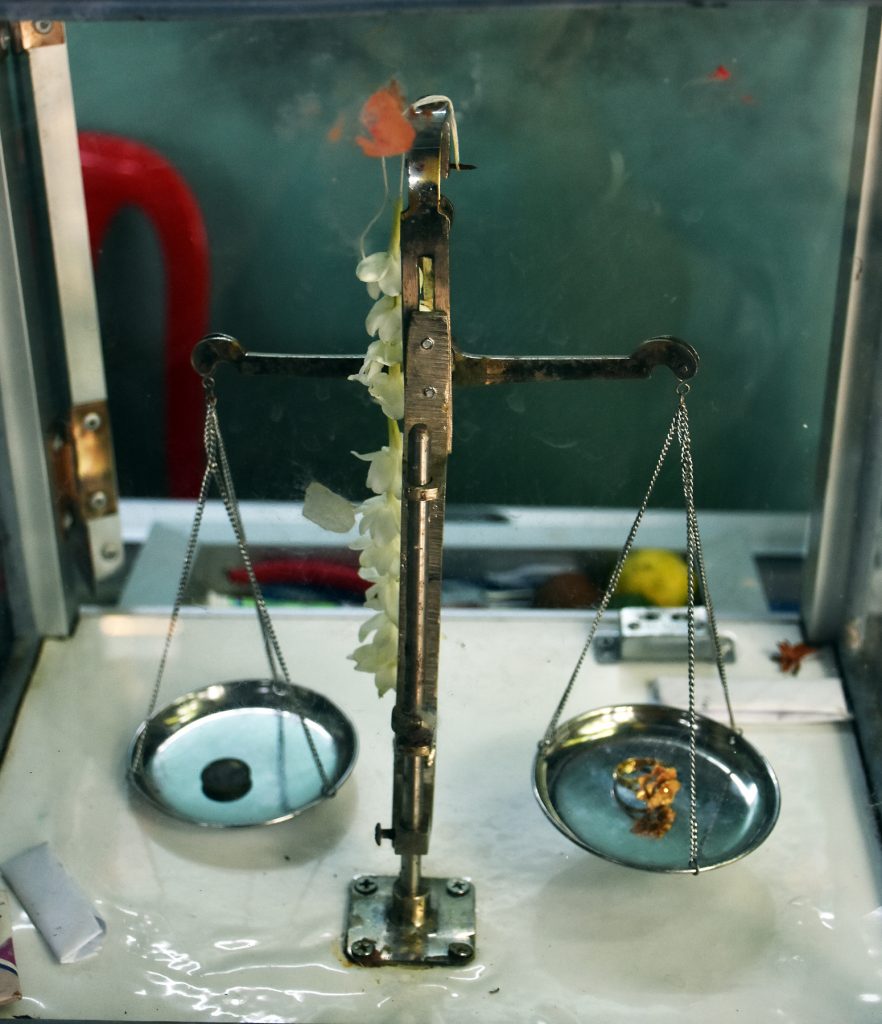
Traders ‘living in fear’
Myo Myint talks approvingly of the calm that has returned to the gold market in the wake of the nine arrests. “Now there are only genuine traders left in the market,” he said. “And we don’t see people queuing up in front of the gold shops anymore.”
But for most traders, and those seeking a financial haven in turbulent times, the restrictions on the gold trade are further evidence of the regime’s desperate attempt to control the economy for its own benefit, regardless of the cost.
Meanwhile, the arrests are not the only development to have sent a chill through the gold market. Some of the country’s most prominent tycoons have been detained in recent months, including Eden Group of Companies owner U Chit Khine and Zaykabar owner U Khin Shwe. Before them, U Zaw Zaw of Max Myanmar had reportedly been questioned, and his status remains unclear, while unconfirmed reports emerged recently that Shwe Than Lwin Group owner U Kyaw Win had been arrested.
This has left many people in the business community wary of doing anything that might attract attention from the regime, said Aung Aung.
Yet, despite its heavy-handed tactics, the regime has been unable to maintain confidence in the kyat.
Since the arrest of the gold traders, Myanmar’s currency has steadily lost value against the dollar on informal markets, sliding from K2,033 on May 13 to K2,290 on July 18 – a fall of 12.6pc. It is unclear if this is tied to the restrictions on the gold market, but local factors do seem to be responsible. Over the same period the US dollar index, which tracks the dollar against a basket of currencies, rose only 2.7pc.
The kyat fell so quickly on July 18 that many gold traders simply suspended sales, because they were unsure how to price their goods.
Speaking ahead of the latest sell-off, Aung Aung said the political situation and lack of trust in the banks would likely push the kyat down further. “When people no longer trust the banks, money needs to be pumped into the economy … the kyat will depreciate further,” he said.
Several traders told Frontier that because gold was now largely off limits, investors were instead turning to other sectors, such as vehicles and real estate. Under previous periods of military rule, when trust in the authorities and banking sector was similarly low, these were popular ways in which to store wealth. “The result will be higher vehicle and real estate prices,” said Aung Ko.
Even if restrictions are eased, he said that the arrests had shaken the confidence of gold traders.
“The nine traders are yet to be released … we are all worried,” said Aung Ko. “Everyone in the gold business is living in fear, wondering when it will be their turn to be arrested.”
* denotes the use of pseudonym for safety reasons


